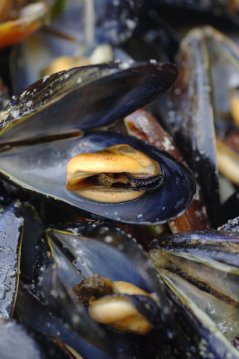
News
Dutch mussels the way to a healthy and sustainable diet
Mussels are known to have a relatively low environmental impact compared to other sources of protein such as chicken, pork, beef and other fish species (including crustaceans and other molluscs). But what are the hidden costs of mussel production, such as negative effects on the environment? Calculating the ‘true price’ of products enables us to reconsider the retail price in the light of hidden costs such as climate damage or child labour.
A review of the scientific literature reveals that this is the first study into the true price of mussels cultivated and harvested in the coastal waters of the Netherlands. This means this is also one of the first true price calculations of a marine animal protein product. Dutch mussels are unique in that, in addition to their environmental impact, their production also proves to have positive effects. These benefits can be seen in the ecosystems of the Dutch coastline and the Wadden Sea.
Mussels as nature conservationists
The most visible benefit that mussels provide to our ecosystem is that they protect our coast, by acting as a natural breakwater. With sea levels rising all around the world, that is a real benefit. But mussels also enrich the biodiversity in an ecosystem. Mussel farms serve as a food source and attract animals both above and below the water, making mussels true bio-builders of the aquatic ecosystem. So it is only logical that mussel farms and oyster reefs are being considered as a means to restore ecosystems around new wind farms in the North Sea.

Mussels are known as the natural filters of the sea. They filter algae out of the water for food, which improves the water quality. This filter function is also why it is so important that no harmful substances enter the water that humans could ingest by eating mussels. So it is good to know that the coastal waters of the Netherlands are of the highest quality, something which cannot always be taken for granted in other parts of the world.
Finally, mussels can help capture CO₂ from the atmosphere. In scientific literature, it is regularly claimed that mussels sequester CO₂. It is believed they use the CO₂ to form calcium to grow their shells, although this view has been contradicted by oceanographic researchers in the latest IPPC report. Nevertheless, most scientists agree that shellfish in general have a low CO₂ footprint with added value within nature based production systems. With some 70% of the surface of the earth consisting of seas and oceans, they form the lungs of the earth, together with the world’s forests. That’s good news in these times when we need to drastically reduce global greenhouse gas emissions to combat climate change and biodiversity degradation.

Air pollution caused by mussel cutters
The mussel production sector does have an environmental impact. The biggest culprit is the air pollution caused by particulate matter emissions, photochemical oxidant formation and acidification. Most of this air pollution is emitted by older mussel cutters that run on fossil fuels like gasoil and diesel fuel. Several Dutch mussel companies are therefore looking into building zero-emissions cutters that will be entirely powered by electricity or alternative, cleaner fuels.
The True Price of mussels
The ‘true price’ of Dutch mussels was calculated to be €4.76 per kilogram in 2021, of which €0.47 for environmental costs. The ‘true value’, being the positive contribution of mussels to our natural capital (thanks to their water purifying and biodiversity enhancing properties), was €0.14 per kilogram of mussels on store shelves.
The true price is calculated based on existing Life Cycle Analyses (LCAs). This methodology follows international standards and the scientific literature. It should be noted that this study deviated from the standard approach to calculating the true price by combining the social benefits and costs into a single net true price.